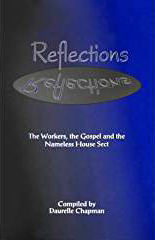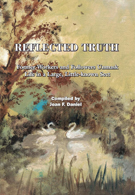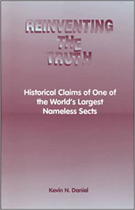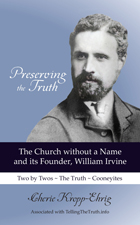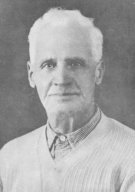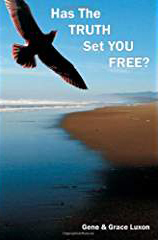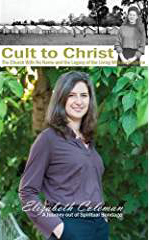LINK to Willie Gill's Funeral
TTT Editor's Notes: As background, Hazel Hughes is the sister of the late Garrett Hughes, who was a Regional Overseer in Eastern USA. Hazel and her brother Garrett were children of Fred Hughes and Mary Ann (Gill) Hughes. The Gill family professed in
June 3. 1951 – Death of William Gill. The Overseer of England and possibly of all Europe, Willie Gill, passed away, aged eighty-eight. His funeral service was held at West Hanney, England. Willie, his sister Emma, and some other Workers are buried in the graveyard at St. James the Great Church in West Hanney, a five-minute walk from the Convention grounds at Oxfordshire (aka Berkshire), England. Jack Forbes replaced him.
Taken From A Tape Made by Hazel Hughes, 1971
Planned by Margaret Siegel
Father (Fred Hughes) and Mother (Mary Gill) moved to Cando [North Dakota] in 1893, (See Footnote #1)
and they felt they should have some church service. So they and the
neighbors started Sunday School in a school house. Then they felt they
should have a church building. So the neighborhood got together and
built a church. Later on that church was struck by lightning and burned
down. So the neighbors got together and built a second church.
The folks taught Sunday School. Father taught the Bible class and Mother
the teenage class. But they weren't satisfied, and one time Mother
asked the preacher, "What's wrong with me? I feel there's something
more that I should know in understanding God." The preacher said, "Oh,
you are a good wife and a good mother. You don't need to worry." About that time, in 1898, the gospel came to the relatives in Ireland and
a number professed. (See Footnote #2)
A man by the name of William Irvine came. He had been preaching in Tipperary (See Footnote #3) and Jack Carroll had met him there. Jack Carroll was from Rathmolyon, from the same district as our Father and
Mother [the Hughes and Gills] came from. (See Footnote #4) And he had heard the gospel and
he felt he needed to be born again, so he got William Irvine to come to Rathmolyon.
(See Footnotes #5 & #16) Dora Holland had heard it before
that in 1895 in Tipperary; (but) there was no fellowship. She never
was in a fellowship meeting for five years. (See Footnote #6)
But he [William Irvine] came to Rathmolyon and preached in a hall there.
That hall is still standing, and Garrett and I were in that hall when we
were back there. (See Footnote 5B) There were 40 people professed and 16 went in the
work from that hall. (Footnote #5) That hall was just
across the street from the old Episcopal Church, [Footnote #7] where our Mother's folks
went to church, and also close by the house where our mother was born (Stone's
house. Stone's daughter is in the work in U.S.) (Footnote #10B)
When we (Garrett and I) were back, we visited the old Episcopal Church [Footnote #7] where our Mother used to play the organ. We looked at the graves, and I noticed one grave was especially cared for,
most of the graves were just in a weed patch. But this one grave was
at the front of the church and very well cared for. So I went and looked
at it, and it had a headstone with the name "Reverend Wetherell" on it.
W-e-t-h-e-r-e-ll. Our Mother used to talk about Reverend Wetherell.
He was the preacher when she taught Sunday School. Our cousin, Herbert
Gill, and his wife were with me. They said that when these 40 people
professed that the presiding elder had scolded Reverend Wetherell for letting
those people go. For letting them go out of the church, that he should
have kept them in. But Reverend Wetherell had said, "If people find
something better, can you blame them for not drinking out of a stagnant pool?" The preacher himself had called his church a stagnant pool.
Well, the Vicar or preacher took me in through the church because of the
background, knowing that Mother had gone there. The whole thing that
he was interested in was showing the silver service that they used for communion.
They had it since 1759 or something. And that was the whole thing that they
were so proud of, this old silver service. This church was built by
Captain Fowler, the land owner in that part of the country. He told them
he would build a church, but they were not to start their service or ring
the bell till he got there, even if he was late. He was the lord of
that church. All around in that church were plaques and memorials of
this Fowler and that Fowler and the other Fowler. The whole church
building was dedicated to the Fowlers. He's dead now.
Well, these people came out of that church. Our Father's people, that
would be your grandfather (Hughes), they lived about two miles away from
there, but they were Methodist. They had been Methodists for many generations.
One of Father's brothers professed at that time, Uncle Sam Hughes, and remained
hearty till his death. He died at a Convention in New Zealand in 1925.
He owned "Fox Hill", and there were many meetings in that home. (See Footnote #8)
I must tell you how Uncle Willie felt. That's Willie Gill. (See Footnote #9)
He was a man that had gone in for race horses. He was living a kind
of sporty life, but he wasn't satisfied. But when he heard the gospel, he
felt that God could help him. He said he felt like a man standing in a tub
and couldn't lift himself in the tub, but if somebody stronger came along,
he could lift both him and the tub. So he yielded to the Lord.
Then he made up his mind that he would go out in the work. He would
sell his farm. That was the same gospel meetings in that building that
he went to. (Footnote #5B) Those who had professed
met together. Six of Mother's (Mary Gill) brothers and sisters.
There were eight of them in the family and six of them met together. Mother was in this country. But one brother never professed, Garrett Gill.
(See Footnote #10)
Uncle Willie made up his mind to go in the work, and he sold his farm "Ashmount"
to his brother Harry. Harry paid a certain amount of money into
the work till the farm was paid for. (See Footnote #11) [Insert by Eunice Hughes Krack on 1/17/92: Harry's son, Herbert and
wife, kept the farm an open home until Herbert's death in 1985. Herbert
was working with his nephew, John Swanton, in raising cattle, and he willed
the home farm "Ashmount" at Rathmolyon to him] (See Footnote #12)
Then Aunt Emma Gill and Aunt Jennie (Gill) went in the work. First
Aunt Emma went, then Aunt Jennie made up her mind. They're both dead
now. (See Footnote #9) That's the history of Rathmolyon, the background of where the gospel came from to our home.
Then about 1904, I'm not sure on the date exactly, William Irvine came to our home near Cando (North Dakota). (See Footnotes #13 & 16)
He was looking up people that he had addresses for from friends in Ireland. So Mother said to him, "I suppose you have a lot of people to look up?" and he said, "Yes, I find them most all living in sin." But Mother
thought, "You are not finding us living in sin. We're good people." Then they sang hymns, and the first one he choose was "Amid the Trials Which
I Meet." We sang that that night. And then Mother played the
hymn, "The old fashioned religion t'was good enough for Mary and Joseph,
it's good enough for me". William Irvine said, "That's all right if
it's the right kind of religion; not every old fashioned religion, but to
go back to the days of Jesus." Then he spoke on the 1st Psalm.
The folks always asked the preachers to read a chapter and pray. So
they asked him, and he spoke on the 1st Psalm. Father said afterwards, "That preacher got more out of that Psalm than I ever heard any other preacher
get out of it." So they were impressed. But he just stayed overnight
and the folks continued to go to church.
In the end of 1904, we had a new baby brother (Harry Faucett Hughes). (See
Footnote #15 for full list of Hughes family members) But Mother took pneumonia
and the doctor didn’t think she would live. The baby and I and brother Joe
were sent over to Ebners, because Mother was so sick and the house was small.
So the three of us were sent to Ebners. Lincoln was allowed to stay
at home, and Garrett was sent to another family, the Gehres, where there
was nothing but girls, and he didn’t enjoy himself. At the end of seven weeks
the baby took pneumonia or bronchitis and died in that neighbor's home.
It was a big house, but it was cold. Father came over when he knew
the baby was sick, and he was there when the baby died. Then when he
came home, Mother was still in bed, and she said, "How is the baby?" and Father had to tell her, "He is at rest." That was hard on her because
she had pneumonia and was weak.
I'll have to tell you [about] the night that she took sick with pneumonia.
Father came and called the three of us, Lincoln, Garrett and I, and said, "Come into Mama's room. She's very sick and I am afraid she is going
to die." We stood around the end of the bed. Lincoln was about
14. I was 12 and Garrett 10 or maybe a little younger. Father
leaned over and said to Mother, "Do you feel ready to die, Mary?" She
whispered, "No." And even though we were young, we felt how serious
it was to feel that she wasn't ready to die, and she had worked so hard in
the church and taught Sunday School. She could hardly speak because
of the pneumonia. The doctor came and he said, "If she has any relations
in this country you had better send for them." Aunt Emma [Gill] had just come
to New York to start [gospel] work in America. (See Footnote #14)
So they sent for her and she came. Mother was in bed for many weeks. But after she was out of danger, Aunt Emma started meetings in a school house
about five miles northwest of our home.
She was all alone, no companion, but she had meetings and the school house
was just packed. When Father could leave Mother, he took the three
of us [Lincoln, Hazel and Garrett] and Dick Nass to those Gospel meetings.
We rode along in a spring wagon and team and Father enjoyed those meetings.
That was the time that I first began to realize that I was not a Christian.
The Lord spoke to me in those meetings. I don’t know what she preached
about, but the Lord spoke to me.
Garrett and I were sitting in a double seat, an old fashioned school seat. When they sang that hymn, "When the Roll is Called Up Yonder, I'll Be There." I couldn't honestly sing it [so] I sang, "When the roll is called up yonder,
I'll not be there." Garrett heard me put that "Not" in and he looked
at me kind of surprised, but that's how I felt--that I was not ready.
Then Aunt Emma used to visit with us. She asked Lincoln after the meetings, "If you die what would happen to you?" "I'd go to hell," he said.
He knew he wasn't saved. We got that much out of the meetings.
She used to tell Joe the story about Joseph. He was three years old,
something like that. He got mixed up, and when he told it back to her,
he said, "My brothers took me and put me in a pit." Because he thought
that Joseph in the Bible was himself.
Time went on. George Walker in Ireland was what they call a "lay preacher",
just one of the congregation that would kind of speak when the preacher wasn't
there. But he was sincere and he had a good job in Dublin in a store.
When Uncle Willie told him how preachers went in the Bible, how they sold
all, that was the desire. If you have a chance to visit with George
Walker, he would tell you that. (See Footnote #16)
Time went on. Mother got stronger and when she was able to go back
to church, she told them about how she had been near death's door, and how
she felt she wasn't ready to meet God, but that now she wanted to do anything
possible to please God. She felt that a lot of what she had done in
church work was for her own glory and her own satisfaction, but now she wanted
to do it as unto the Lord. She was really trying to seek the Lord.
Some of the different people had comments – not kind either.
Aunt Emma had left to go preach at Bisbee [North Dakota]. She had a
companion now. No one professed in those gospel meetings at the [local]
school. There were a lot of young folks. I remember one night
there were 90 people there. People sat on the coal pail, just anything.
It was just jammed across. But Aunt Emma had gone to Bisbee and up
by Mylo and up that way. She had a companion now, Maggie Row was her
name. (See Footnote #16) She didn't continue in the work.
She got married and her daughter lives out in British Columbia, out West
somewhere, and when Garrett has been out there for conventions, he met this
daughter and had a talk. This daughter knew that Maggie Row was one
of the first workers in our home.
In the fall, Tom Craig and Ralph Bullock (See Footnote #16)
came and they had a few meetings in Cando. It was thrashing time and
they helped father some, but the folks couldn't go to the meetings because
it was such a busy time. One night we [Lincoln, Hazel and Garrett]
followed them. The two men [Tom and Ralph] walked down to the big slough.
They had a boat there. We children tiptoed and followed and peeked
over the bank to see what they were doing. They were sitting in the
boat and were having a talk, wondering how best to help the folks.
Then they came back and we children were sent to bed. But there were
only curtains in the doorway so we could hear it all. They reasoned
with the folks that they had to leave the church, if they were going to serve
the Lord. They talked till 12:00 at night, and it wasn't easy for the
folks. Finally, Mother said, "We feel you know your Bible and you're
men of God. We'll do it because you say so, although we don't fully
understand." It meant tears.
The next Sunday they went to church, and after Sunday School, Mother stood
up and told that they were leaving the church because they felt it wasn't
according to scripture. Oh! The people were horrified.
Next Sunday, Father went alone, and all the preacher preached about was how
terrible of Mrs. Hughes to say things like that and leave the church. But then Mother talked to the preacher, privately, and told him the reason
she had for leaving the church.
There had been a chicken pie supper a short time before. She was making
the chicken pies for the supper in the church and the two brother workers
were there but she took the pies. When she was in that church and saw
that supper and saw how the people carried on and so little love for God,
she just was disappointed and disgusted, so she mentioned this to the preacher. He said, "I hope you didn't connect the chicken pie supper with Jesus cleansing
the temple of the thieves." But there was a connection. He made
the connection. And then he said to her, "You have always been a conundrum
to me."
These two brothers, Tom and Ralph, came from Canada. There were no
workers in North Dakota then. They came across the line from convention
in Canada. This would be the fall of 1905. The first Sunday that
we didn't go to Sunday School, Mother cried because all the children that
she knew around us that didn't go to Sunday School were playing ball or going
wild, and she wondered what to do with us. And then the thought came
to her. If I follow this up, maybe some of my children will go in the
work. She had other plans. She wanted us to have education and
go on in the world, but then she decided that the will of God was to be done.
When Mother had been so sick, Father had said to her, he was trying to help
her have courage to get better, get well. He said, "What would you
like most of all? What would mean the most to you?" "Oh," she said, "If I could just see my Mother." It had been about 15 years since she'd
seen any of her folks. So then they made plans to go back to Ireland.
And they took all four of us children. Lincoln, Garrett, myself and
Joe. That was in the fall of 1905. We went back in December and
came back here in April. When they got back there, there were meetings
in Father's brother's (Sam Hughes) home at "Fox Hill", and they saw what
a fellowship meeting was like, and they saw fellowship meeting in Dublin,
and they also saw a baptism. I saw a baptism. It was winter time
and, of course, it's not so cold there, but Annie Hughes was baptized. They heated a boiler of water and poured it into a little hole in the creek
and baptized her in January.
We came back in April, and when we came back Robert Darling was there. (See
Footnote #16) And we thought he was a hired man when we got there,
but we found out he was a worker. A saint man from Canada was doing
chores at home, Bill Corcoran, while the folks were gone. And these
workers, Tom Craig and Ralph Bullock, stayed in the home and worked around;
and then this Robert Darling had come, so there were three workers there
when we came back.
The folks did not go back to the church, but some of the church members came
and said, "When are you coming back to church?" And Mother said, "We're
not coming back." She said, "I have to look after my own children." They said, "A lot of good that will do you, to just teach your children at
home." And they were real sarcastic.
Eunice, my sister, was born in July. Before the workers left, between
April and July, I don't know just what time, Father asked if he could be
baptized. So they took him down to a place where there was water by
the railroad just east of the house, and we saw Father baptized. Mother
couldn't be baptized because Eunice wasn't born yet.
Then they started in to try to teach us, to get us to read Bible stories
and memorize verses. Mother called us and she asked us, "Why do you
like to go to Sunday School?" Lincoln said, "I'm ashamed to tell you." But he said, "I like the story papers." Mother said, "We'll find some
other papers for you." Then she asked me, "Why do you like Sunday School?" I said, "To see the other girls." Both of us knew that this was a very
poor excuse for going to Sunday school. But they tried to teach us,
and I wasn't very willing…I had a stiff neck, but I did what I was told. Then Tom Craig came, and he said to me, "When are you going to begin to live
for God?" I was a little bit owley and I said, "I'm too young yet." Then he went to Nebraska that winter, and he wrote back and told about a
girl that had professed that was 14, and he said in a letter, "Tell Hazel." I knew what he meant. This other girl was young and had professed,
and I should know.
A year later we had special meetings in the granary. Mother was baptized,
and Lincoln said he wanted to be baptized. Mother said, "He doesn't
understand." But the workers talked to him and they felt he did understand.
So Lincoln and Mother were baptized a year after your mother (Eunice) was
born. That would be in 1907, and oh, that condemned me to think that
Lincoln was going to be baptized. I was taking care of Eunice.
She was a year old, and I just thought it was very nice to take her outside,
out of the meeting. I was glad to have an excuse. Aunt Emma said
to Mother, "Hazel should be sitting in that meeting. She shouldn't
be going out with that baby." So she was "on to me."
That fall there was a convention in 1907 (See Footnote #17)
There had been several in Manitoba. So Mother and Lincoln went up to
convention. Convention lasted about three weeks those times. Mother
had weaned Eunice from the bottle, and Father was going to look after her
while Mother went to convention. So he gave her back the bottle.
That was the easiest way to take care of her. Mother came home and
Lincoln stayed at convention. Father said to me, "Wouldn't you like
to go to convention?" I thought it would be nice to have a train ride.
We had to go to Brandon on the train and stay overnight in the hotel, and
then take the train to Sidney. But I knew Father wanted me to go on,
so I said I'd go. I had just started High School.
I'll have to tell you this too. I was working for my board in Cando,
no cars, and I worked in a home and then I came home Friday night. This one Friday night, when I came home, Mother said, "You'll have to look
after the younger ones, Joe and Eunice, because we're going to a meeting
up by Zion." "Oh Mother," I said, "I've just come home, and I
am lonesome for you and you go and leave me." She said, "We're going
to that meeting." I cried a little, but they went to that meeting,
and I stayed home with the children. They only had a single buggy…room
only for two or three.
We went to Sidney to convention, Father and I. I sat in three meetings
and at close of the third meeting, I stood up and said, "I want to live for
God." I didn't know that they tested the meeting. I just was
so troubled and desperate I could see if I didn't begin to live for the Lord,
I'd be lost. So I stood up and said, "I want to live for God"; and
then Maggie Sandford, an older woman from North Dakota, stood up and said
the same thing. So that was my beginning.
Garrett professed at Sidney two years later. The five of us had little
meetings every Sunday. We used to have them at 2:00 because that was
the hour we used to go to Sunday School. And at first when we were
having a little meeting and a neighbor would come, we would think, "We'll
wait till they go away."
SSK 3/14/92
Footnotes added by Cherie Kropp
Footnote #1: Mary Ann Gill Hughes was the third child born in the Gill family of nine (9) children, who lived in Rathmolyon, Ireland. She was born October 5, 1864 and was baptized November 30, 1864 in the Church of Ireland. Her parents were Garrett Gill and Ann Gill (nee Piggott). Mary Ann Gill and Fred A. Hughes were married on February 25, 1891. They emigrated to America, possibly in 1892. (Unable to find Ellis Island record for them) In 1905, they left their local church in North Dakota and started worshipping in their home.
Footnote #2: Their relatives in Ireland who professed were the Gills, Mary Ann's family; and a brother of Fred by the name of Sam Hughes. In Rathmolyon, Wm. Irvine and John Long held meetings for the Faith Mission for three weeks, from October 10 through 31, 1897. In Accounts of the Early Days, Goodhand Pattison wrote: "...from Nenagh's first visit, William [Irvine] went to Rathmoylon through the Carroll's introduction, where as you know he had another very successful mission, getting hold of nearly all the best type of character in the place, including the Gills, Carrolls, Hastings, Winters and others, and from there back to Nenagh a second time, after which he booked for here." [Cloughjordan].
Jack Jackson stated at Willie Gill's funeral on June 5, 1951, that by his calculations, it was 53 years and 8 months since Willie and some others at Rathmolyon made their choice saying, "Lord what will Thou have me to do?" This dates back to October, 1897.
Footnote #3: It was in August, 1897, that Wm. Irvine preached the Nenagh Mission in Tipperary County, Ireland.
Footnote #4: Rathmolyon is located about 25 miles Northwest of Dublin, Ireland, in County Meath. This is where Wm. Irvine preached the October, 1897 Mission.
Footnote #5: According to John Long, "... a young man named Jack Carroll...had a brother, Bill Carroll, who was a steward at Captain Fowlers, Rathmolyon, County Meath. Through their instrumentality they got the use of the School House in Rathmolyon for a mission for William Irvine, where forty persons got converted; most of them afterwards gave up their situations to go fully on the Lord's work." (From: John Long's Journal, September, 1897). Cherie Kropp toured this school house in August, 2004, and saw the room that would have been used for the gospel meeting, and took photographs.
Garrett Hughes, son of Mary Ann and Fred Hughes, brother of Hazel Hughes, and also a U.S.A. Overseer (deceased), reported a similar account of what he termed as "the beginning" at the October 6, 1987, funeral service for Erling Omdal, held in Eagle Bend, MN: "Ninety years ago, a letter came from Ireland. We heard about those with no home, no name, etc. Forty people made their choice. Sixteen went out in the work - that was the beginning...There is not a country not open to the gospel now. It is the most marvelous thing ever to happen." (Note: 1987 minus 90 years = 1897, the year of the Rathmolyon Mission.)
Footnote #5B: The hall where the meetings were held was demolished around 1990. It was located a 100 yards from the Church of Ireland, and was known by the names, "The Meeting Hall," "The Old Gospel Hall," "The Lecture Hall" and "The Fowler Hall," which was it's most commonly recognized name in earlier years. It was built by the owner of the Estate where Bill Carroll worked, The Fowler Estate of Rahinstown.
Footnote #6: Sydney Holt, nephew of Dora Holland, stated in a letter "Time ran out, so we didn't drive 70 miles on south to Kilrush where Aunt Dora (Holland) met Wm. Irvine and his companion right after they came from Scotland in 1896. She was in her early twenties and working as a tutoress for a wealthy family at the time. She didn't have much fellowship until she started in the work in 1902." (June 27, 1985 Letter) In 1896, Wm. Irvine was preaching with the Faith Mission, with whom he was associated for 6 years, from 1895 to 1901.
Dora Holland is credited with being THE FIRST PERSON TO PROFESS. An extract from a letter written in 1966 by her brother, Harry Holland reads: " My sister, Dora, was 90 on January 1st. She was the FIRST PERSON TO PROFESS in Ireland, but that was before the Gills and the Carrolls decided and before George Walker decided. That was some years before I left Ireland...in 1899." Click Here for more about Dora Holland.
Footnote #7: The "Episcopal Church" referred to above is actually the Church of Ireland, or Anglican. In the USA, it is called Episcopal. So the old "Episcopal Church" where Mary Ann Gill played the organ, is actually the Church of Ireland in Rathmolyon village, which was built in 1797. The address is:
St Michael’s and All Angels,
Church of Ireland,
Rathmolyon,
Enfield,
Co. Meath,
Ireland
Footnote #8: Fox Hill is a beautiful period home, still standing, and in excellent repair. In the year 2004, it is occupied by Sam and Ethel Hughes, and the address is: Fox Hill, Rathmolyon, Co. Meath, Ireland.
Footnote #9: Willie Gill was Mary Ann Gill's brother, and Emma Gill and Jennie Gill were two of her sisters. Willie was born in 1863, and died in 1951, aged 88, and both he and Emma are buried in a churchyard in West Hanney, Oxfordshire, England. He is pictured on the Bicycle Boys photo taken in October, 1899. Willie Gill was the first from the Rathmolyon mission to go into the work; and he was one of nine brother workers to go out in the work in 1900. Reportedly, he was the Overseer of the 2x2 sect in the British Isles from 1914 until his death.
Emma Gill and Jennie Gill were two of the first four sister workers to go out, and they entered the work in 1900. Emma died in 1945, aged 74 and is buried at West Hanney, Oxfordshire, England. Jennie died in 1939, aged 63, and is buried at Bletchley near Milton Keynes, England.
Footnote #10: The above Account by Hazel Hughes states there were eight children in the Gill family; however, church records show nine children were baptized into the Church of Ireland in Rathmolyon. The family members were:
Father: Garrett Gill (born 1830, Edenderry, Co. Offaly, Ireland)
Mother: Ann Gill (nee Piggott) (born 16th February 1834; Baptised on 9th March 1834
Children:
1. Susan Jane; born 14th February 1862, baptized 17th March 1862
2. William John; born 12th June 1863, baptized 8th July 1863
3. Mary Ann; born 5th October 1864, baptized 30th November 1864
4. Garrett (Junior); born 19th February 1866, baptized 6th April 1866
5. Sarah Ellinor; born 25th December 1867, baptized 19th February 1868
6. Philip Henry; born 11th October 1869, baptized 16th November 1869
7. Emma Emily; born 9th October 1871, baptized 6th January 1872
8. Paul Fawcett; born 23rd April 1874, baptized 7th June 1874
9. Janet Goodwin (Jennie); born 24th February 1876, no recorded baptism date.
No baptism date recorded for Janet Goodwin (Jennie).
Garrett Gill built "Ashmount" around 1872 on property he owned. The address of the Gill Family home from 1872 until 1895 was:
Ashmount, (Click for Photo)Footnote #10B: In 1895-96, Garrett Gill Senior bought a house and farm from John Fox at Dalystown, Castlerickard approximately 6 miles from Rathmolyon, where he moved with all his family, except Philip Henry (Harry), who was married. The original family home in the village of Rathmolyon where Willie and Mary Ann were born, as well as the farm at "Ashmount" became the property of Willie Gill, as well as a farm in Rathmolyon. This farm is where the FIRST two Conventions took place, in 1899 and 1900.
Kill,
Rathmolyon,
Co. Meath,
Ireland
Footnote #11: Willie Gill's brother, Philip Henry, called "Harry" married Lilian and bought Willie's farm. They had a son Herbert who had no children; a daughter named Mary Stewart and a daughter named Olive (Gill) Swanton. She died age 104 on February 1, 2010, mother of John Swanton.
Footnote #12: Herbert's wife died and they had no children so he willed Ashmount to his nephew, John Swanton and he and his wife, Joyce, are the current owners and live at Ashmount (2004). Cherie Kropp visited with Mr. & Mrs. Swanton in August, 2004 and toured the home and grounds, and took photographs.
Footnote #13: The first worker the Hughes ever met was Wm. Irvine, the founder of the sect. Most likely, Wm. Irvine was the first worker to go to North Dakota. A discrepancy exists as to who Fred and Mary Ann Hughes professed through. An account by George Gittins states that it was through Wm. Irvine, while Hazel Hughes in the above account, states they professed through Jack Craig and Ralph Bullock.
Footnote #14: According to the Ellis Island records, Emma Gill came to America, along with seven other workers. They departed from Liverpool, Eng., U.K. on November, 1904, on the Ship Oceanic, and arrived in New York on December 8, 1904. The Ellis Island records show: Emma Gill, 33 yrs of age, Single, Irish, Residence, Meath.
Footnote #15: (6) Children of Fred & Mary Ann (Gill) Hughes - Birth Order:
1. Lincoln Hughes born in 1892 (approx); professed in 1907
2. Hazel Elizabeth Hughes born August 8, 1893; professed in 1909; went in the work in North Dakota June, 1920. On September 19, 1975, during Utica, SD convention, Hazel Hughes, aged 82 was struck and killed by a car, while she was crossing the road with the mail.
3. *Garrett G. Hughes born 8/15/1895 near Cando, North Dakota; professed in 1910; in work Nov. 1920; died 7/19/91in Denver, Colorado, age 95 years, 11 months; buried in I.O.O.F. Cemetery in Cando, ND.
4. Joe Hughes born in 1900-01 (approx)
5. Harry Faucett Hughes born in 1904 (died in infancy)
6. Eunice Mary Hughes born 7/16/1906; died 10/23/96; married Elmer A. Krack. They had four children: Paul, David, Margaret and Hazel Krack, who went in the work in 1961. Mr. Krack died 11/23/95.
Footnote #16: WORKERS mentioned in above account:
According to the 1905 Workers List:
• William Irvine entered the work in 18--. (He was born January, 1863 and died March, 1947 in Jerusalem. He is buried in Zion Cemetery in Jerusalem, Israel. See also Notes on George Walker's EARLY DAYS in AMERICA
• George Walker entered the work in 1900. (He was born Feb. 12, 1877 in Co. Fermanagh, N. Ireland to John & Jane Walker, and died Nov. 6, 1981, age 104 years. He is buried in North Wales Cemetery, Pennsylvania. He became the Eastern USA Overseer. See further details.
• John Thomas Carroll (Jack) entered the work in 1904. He was born in Co. Meath, Ireland. He was the brother of May, Fannie and Wm. (Bill) Carroll. He was the Overseer of the Western USA. He died March, 26, 1957, was given two funerals; and is buried in WA. He pioneered the work in British Columbia, Canada and Washington, USA in 1907. Click here for Sermons by Jack Carroll.
• Tom Craig went in the work in 1903 (He pioneered the work in Nebraska in 1907, with Hugh Doak.)
• Ralph Bullock is not found on the 1905 Workers list; however, Robert Bullock is listed as entering the work in 1903.
• Maggie Row isn't listed.
• Robert (Rob) Darling entered the work in 1905. (He died in 1970 and is buried in Buenos Aires in a British Cemetery. He pioneered the work in Alberta, Canada with Noble Stinson in 1907. Read what he said about the Early Days.)
Footnote #17: The first Convention in North Dakota was held at Page in 1912; the first convention at Cando, ND was held in 1926. The convention held at Sidney, Manitoba, Canada was in 1907.
Footnote #18: Family of Fred Hughes
Father: Samuel Hughes, Farmhill, Rathmolyon, Co. Meath.
Mother: Elizabeth Kerr, Rathmolyon, Co. Meath
Married 9th November 1852
Children; (5)
1. Mary Millicent born 14th Feb. 1855; baptised 17th Mar. 1855
2. Samuel born 16th Dec. 1856; baptised 6th Jan. 1857
(This is the Sam that Hazel Hughes spoke about who died at the Convention in New Zealand in 1925)
3. Frederick Alexander (Fred) born 14th June 1858; Baptised 11th July 1858
4. Babez Joseph born 23rd July 1862; baptised 24th Aug.1862
5. Anne Jane born 29th July 1866; baptised 6th Sept. 1866
(This is "Annie" whom Hazel Hughes mentions was baptised in the little creek at ‘Foxhill’.
She is pictured in the 1921 Staffordshire Convention photograph as No. 147 beside Jennie Gill who is No.146.)
*Garrett Hughes wrote two hymns printed in Hymns Old & New:
No. 193 In the Garden and
No. 248 How Blest Are They
CREDITS:
Most of the local details for Footnotes provided by Jim Mallon, long-time resident of Co. Meath, Ireland.
Thanks to an anonymous provider for this article.
See also: Article "1888 Friends & Workers" Regarding Hazel Hughes

 REPRESENTING THE LARGEST COLLECTION OF 2X2 HISTORICAL DOCUMENTS ON THE INTERNET
REPRESENTING THE LARGEST COLLECTION OF 2X2 HISTORICAL DOCUMENTS ON THE INTERNET
 Perry, Oklahoma Conv, 1942
Perry, Oklahoma Conv, 1942
